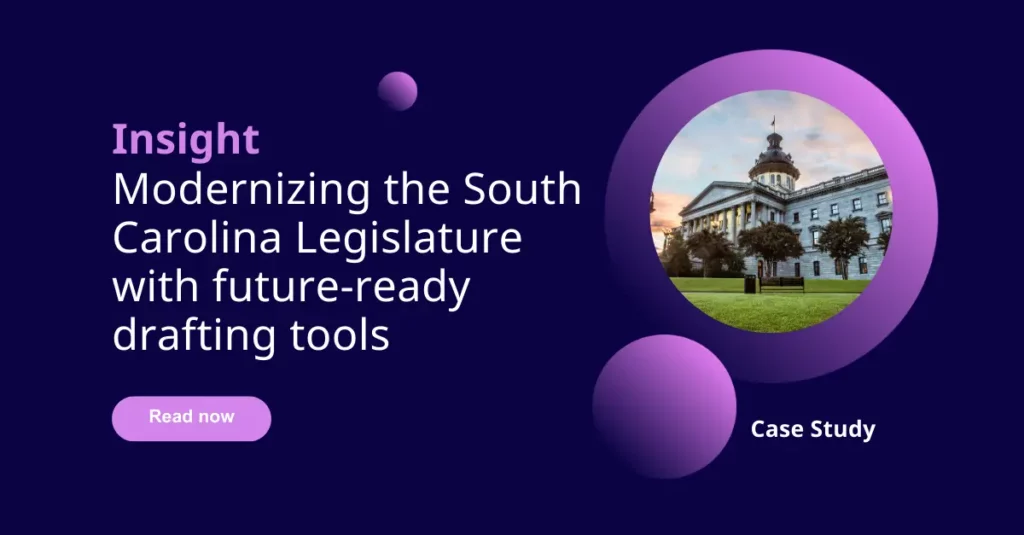When the dot-com bubble burst two decades ago, it sparked misconceptions about the future of technology. Many assumed it was a sign that innovation had failed. However, while flashy internet startups crumbled, a quieter revolution was happening. Technologists were refining foundational web technologies that ultimately re-defined our concept of what could be done in a browser.
Standard Generalized Markup Language (SGML), developed in the 1980s had set the stage for the structure of web content, known to the world as HTML. HTML became the publishing format backbone of the internet and when paired with the HTTP publishing protocol, became the basis for all future web development. Later on, XML emerged in the late 1990s as a more streamlined subset of SGML which in turn lead to XHTML, further strengthening the technologies for future layers to be built on top.
From the technologist’s perspective in the eighties, XML seemed poised to transform legislative drafting. Legislative document types – bills, acts, statute, agendas, etc – all have the sort of hierarchical structure that XML is designed to handle.
XML’s power in publishing, document management, and content consistency quickly garnered attention in governments worldwide, leading to the adoption of popular XML editing tools of the era such as XMetal and Arbortext XML Editor, both of which are derived from older SGML editors. These editing tools seemed to be on track to revolutionize drafting but there was a catch.
From Generation Four to Generation Six: Evolving Legislative Technology
For much of the early 2000s, legislative IT departments were the primary champions of structured documents. Meanwhile, drafting attorneys remained loyal to word-processing tools like WordPerfect and of course, Microsoft Word. As we’ve covered previously, despite continued support from Corel, WordPerfect’s future is uncertain as it struggles to keep pace with Microsoft’s evolving Word features, leading to a declining user base.
In our eBook, Drafting Technology in US State Legislatures, we identified six generations of technological evolution, beginning with Generation One, 1970s and the ‘green screen’ era. XML editors gained traction in Generation Four but as we progress through Generation Six – 2020s and the cloud – the technological landscape has shifted.
The COVID-19 pandemic was a watershed moment, accelerating the move toward remote work and cloud-based solutions. There has been an increased focus on security as organizations double down on standards such as ISO 27001.
One clear trend has emerged: thick-client applications, which require installation on individual computers, are now firmly on the decline. Thin-client applications that can be accessed via browsers are gaining favor. Legislative staff can securely access the tools and technology needed to support their work without needing to be concerned about accidentally installing malware. This is always a risk with thick client applications.
While the dot-com bubble was bursting two decades ago and highly visible internet startups crumbled, a quieter revolution was happening.
Adapting Legislative Tools for Modern Needs
In the early 2000s, Generation Four XML editors like Arbortext XML Editor and XMetal sought to unlock benefits such as:
- Content consistency
- Single source publishing, reusing the same content across multiple formats (e.g., web, print, PDF)
- Streamline collaboration
However, while these tools gave a high level of flexibility to engineers and technologists, they presented challenges for drafting attorneys whose key task was ensuring the constitutionality and legal accuracy of documents. The specialized nature of these tools, while ideal for certain tasks, created a learning curve that did not align with the day-to-day workflows of legislative staff.
As the needs of the legislature continue to evolve, Generation Four tools are becoming legacy as legislatures begin to look for solutions that balance technical capabilities with ease of use while also being thin client to meet cybersecurity requirements.
A New Era: Generation Seven and Beyond
The user experience of XML editors has improved significantly since their earlier Generation Four thick client implementation. Simultaneously, for those who want to continue working with Microsoft Word, the preferred tool for drafting, Microsoft has since brought out the .docx file format and new APIs. This has created opportunities for drafting in Microsoft Word, maintaining the intuitive environment that most drafting attorneys want while creating high-quality structured documents behind the scenes.
These tools, integrated into cloud services like Microsoft Office 365, are already pre-installed on most professionals’ laptops, making them an effective part of the thin-client set-up. In addition, by embracing browser-based applications, legislatures are poised to enter the next stage of digital transformation, in which a wide range of other applications are also thin-client based and thus, less and less software is actually installed as it was in previous generations.

